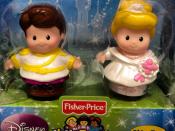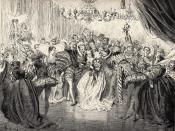The purpose of this paper is to make a comparative analysis of two perspectives on the children's story of Cinderella. It contrasts the time periods and cultures of France and Germany, whereas one was told to royalty and another to peasants. The constants of each version, such as the shoes and the prince will be compared as well.
In Charles Perrault's "Cinderella", there is magic and music. This French version appears to have been written for royalty. The King's Ball, the fairy godmother, all of the actors and actions come together to create a peaceful and harmonious conclusion. Cinderella's forgiveness following her family's cruelty allows for a "happily ever after" ending for Cinderella, as well as her sisters; this is a story befitting royalty. The glass slippers are only something attainable with great wealth; therefore, the audience can better comprehend the majesty of it all.
In contrast, there is Jacob and Wilhelm Grimm and their tale of "Ashputtle".
The German version, with its pagan magic, spell casting, and self mutilation is much more violent and aggressive. This style was obviously written for lower class citizens, peasants. Peasants would have a wedding celebration as opposed to a ball, and gold slippers were considered precious and invaluable to the audience, the idea of glass slippers would have been incomprehensible to them. The punishment of the stepsisters would leave a modern audience wondering, what happened to "happily ever after?" How can Cinderella possibly enjoy her happiness while carrying partial guilt for her step-sisters blindness? However, in the German culture of that era, the punishment was viewed as just and Cinderella would have her happiness without guilt.
In comparison, the theme of each version seems consistent. Each story presents their perspective audience with a girl who is put upon by her family from...


